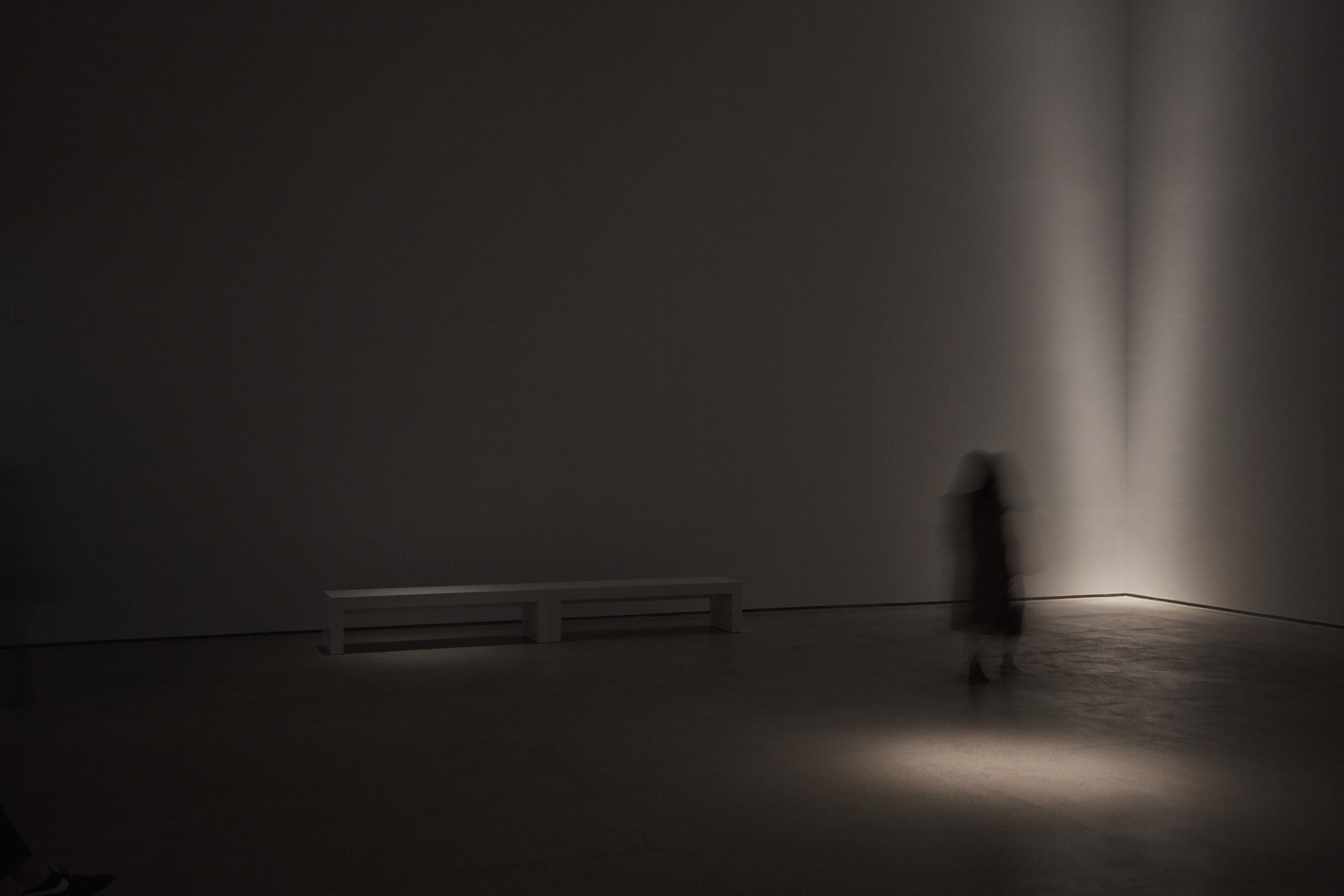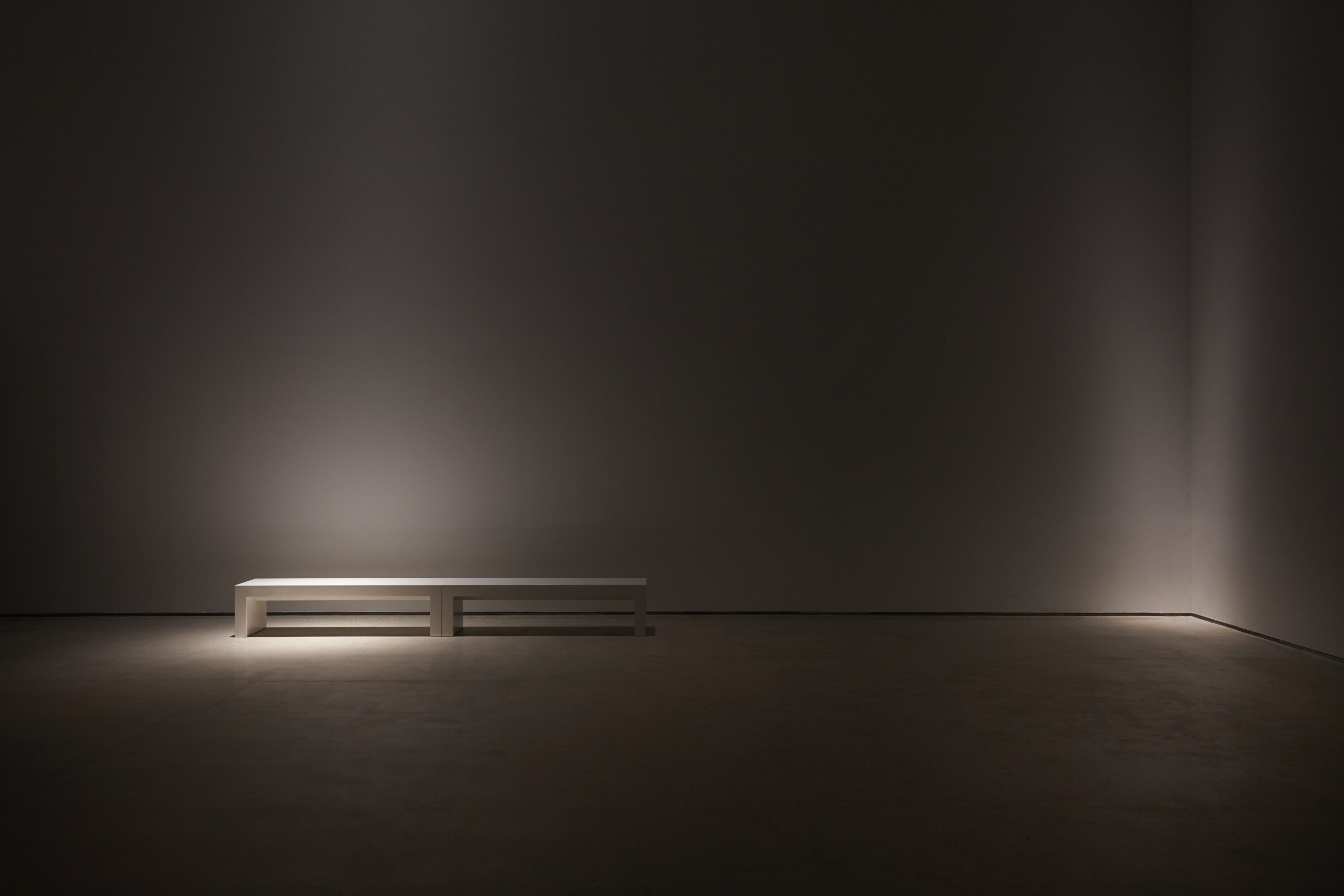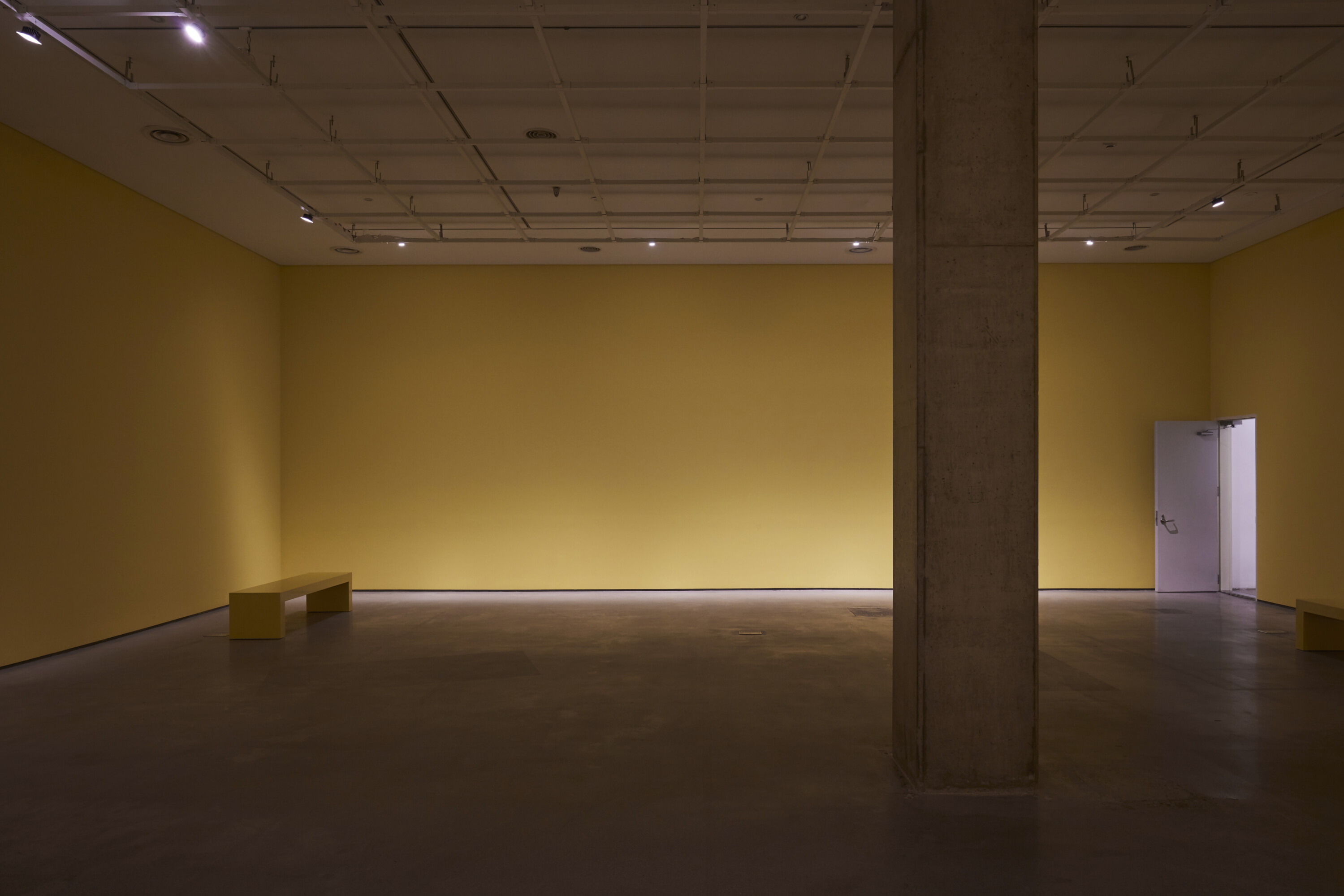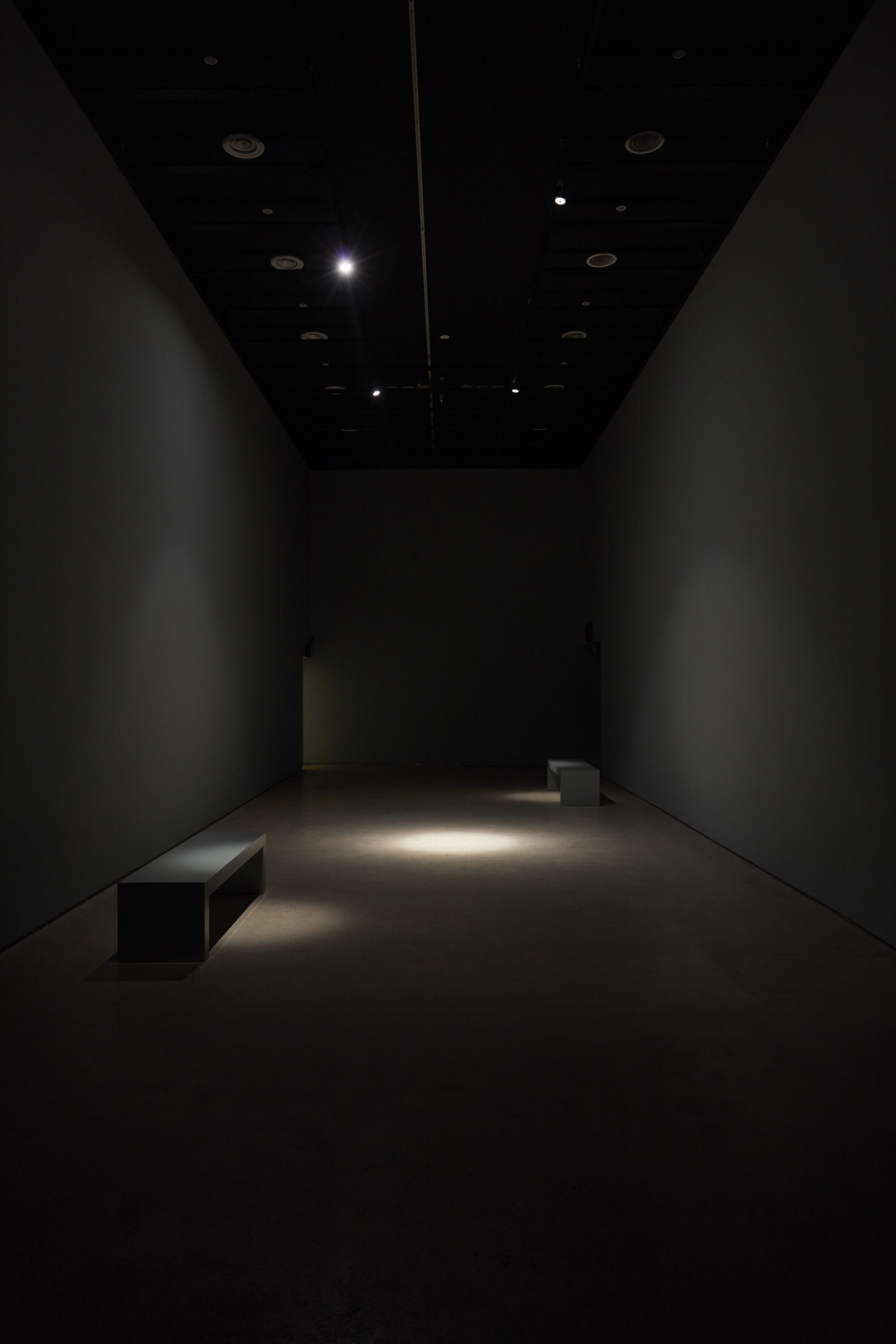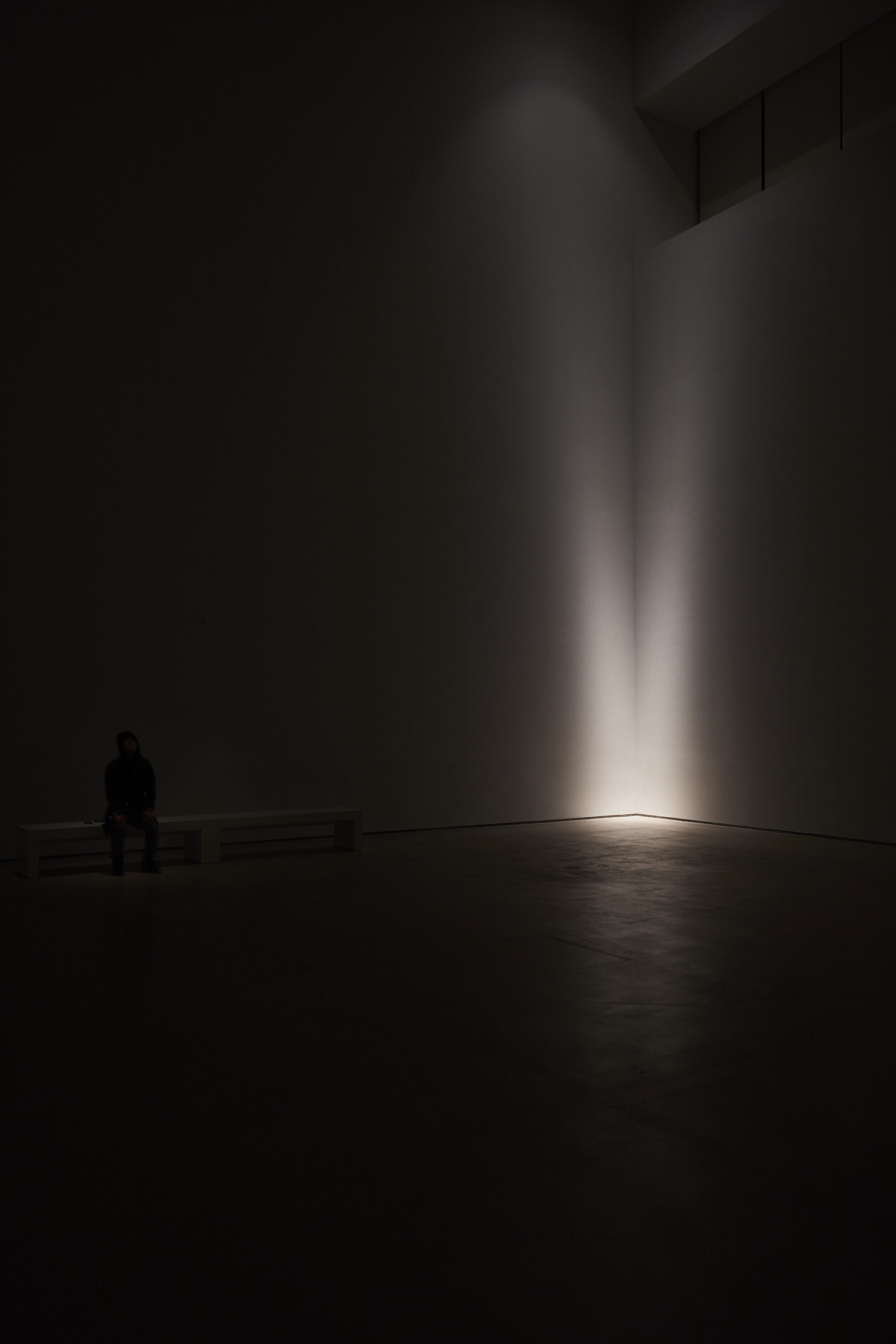liight chamber
produced by jang minseung + jung jaeil
For the last two months, we have been spending time in the empty space of MMCA Gallery 6, listening to music, having cups of coffee, or just sitting without specific things to do.
One can see the experience of spending time quietly without paying attention to the surroundings as a very simple and ordinary action. However, it is difficult to come up with such an empty space in the time when everything is filled with an intense density. For this reason, the tranquil time that we have spent for producing our work felt as if every moment was special and insignificant actions were rituals.
In the meantime, we were reminded of a time when we installed A. intermission where we stayed for a week in a building that had been used as barracks for military drivers. We did the work for Platform in Kimusa, a contemporary art exhibition that took place in 2009 before the museum (MMCA Seoul) was constructed in here. By remembering the memories of the time, we came to take a close look at the situation where we sit together in this place after a certain period of time has passed.
Visiting a museum or visiting MMCA Seoul in particular can mean different things to people. Some might visit the museum purely for seeing a specific exhibition or work of art while others might expect to have a special experience that comes from freely moving and repeating certain choices and concentration in the space of the museum that is rather quiet than its massiveness.
The fact that a museum provides something theaters or libraries cannot makes us think that MMCA Seoul might be a place like an oasis in a dense city like Seoul. Furthermore, we have come to think that the museum might function as a void in people’s everyday life, different from what it does to us that recognize the place as a workplace in a broader sense.
However, we often encountered scenes where the museum housed too many artworks and the density of visitors reached the level of limitation, as a huge and spacious house can lose its audiovisual tranquility once it holds too many household goods and residents. In contrast, the lightings on artworks are turned off and all the visitors vanish on Mondays when the museum is closed. That was the time when the museum provided a moment in which we could experience its space fully, and we could feel the space as a huge void. (As the museum changed its policy to open all year around, the time we spent on Mondays became something that we cannot experience for a while.)
Moreover, when the Gallery 6 was completely emptied after the works from the previous exhibition were deinstalled, we could fully focus on the space and sense it through the absence of the object to appreciate. The state of being empty without any meaning was beautiful as it was pure by itself. The space became a silent and dark enclosure or chamber. Thanks to the transformation, the space enabled us to delicately pick up sounds from distance or a small flow of air rather than focusing on the visual sensation.
When artists are given a spectacular space, there are many cases where they respond to the space in a way that exposes their expressive capacity too much. When one has to ‘format’ the data, which means to completely erase the stored data, one happens to hesitate as it is easy to buy things but difficult to throw them away. As artists participating to Void, we came to this point by deleting our ideas every day and restoring trivial flaws in the exhibition space.
While we were listening to different kinds of music in the space, we were overwhelmed by a certain atmosphere. It was when we played music composed of voices of a single person or only a few people, and we could not say a single word. The voice of a single person filled up the space that has not been dominated by any grandiose musical instrument, and it felt as if the voice filled different spots around the space to the point where we could not distinguish where the sound came from, floating around the space. The sound felt like air or wind, reminding us of azan, the call to prayer we can hear in Islamic countries. We think that such sound/music is the most proper format for our work as we have been investigating certain experiences where one feels different human senses as well as the trajectory of one’s life.
우리는 지난 두달 동안 아무것도 없는 전시실 6의 텅 빈 공간에서 음악을 듣기도 하고 커피를 마시기도 하며 무심히 앉아 있기도 했다.
주변을 신경 쓰지 않고 조용히 시간을 보내는 경험은 지극히 단순하고 평범한 행위라고 여겨질 수 있지만 밀도로 가득 찬 오늘날 주변에서 마땅히 이러한 빈 곳을 떠올려 볼 수가 없다. 그런 까닭인지 우리가 작업을 진행했던 고요한 지난 시간들은 오히려 매순간 특별한 것이 되고 사소한 행위도 의식처럼 느껴졌다.
한편 우리는 2009년 이곳에 미술관(서울관)이 건립되기 직전에 열렸던 현대미술 페스티벌 <플랫폼 인 기무사>에서 낡은 운전병 막사에 일주일동안 머물며 특정 공간을 위한 음악 설치 작업
A.intermission을 했던 때를 상기했다. 당시 기억들을 떠올리며 그로부터 시간이 흘러 이곳에 둘이 앉아 있는 상황을 유심히 들여다 보게 되었다.
미술관에 간다는 것, 아니 좁은 의미로 서울관에 간다는 것은 특정 전시나 작품을 보기 위한 순수한 관람객도 있겠지만 웅장한 실내에 비교해 비교적 한산한 이 공간에서 자유롭게 이동과 선택적 집중을 반복하면서 발생하는 특별한 경험을 기대하는 사람도 있다고 생각한다.
미술관이 극장이나 도서관과 같은 곳에서는 경험할 수 없는 무엇인가를 제공한다는 점은 서울과 같은 고밀도 도시에서 이곳이 오아시스 같은 장소는 아닐까 생각하게 만든다. 한층 나아가 미술관이 넓은 의미로서 일터인 우리와 달리 순수한 방문자들에게는 일상의 보이드로 기능하는 것은 아닐지 생각해 보게 되었다.
하지만 넓은 집에 가도 살림과 식구가 많으면 시청각적 고요함을 상실하듯이 넓은 미술관도 때론 너무 많은 작품과 이를 보기 위해 찾아온 사람들의 밀도가 수용 한계에 이르는 장면을 자주 보게 되었다. 이와 대조적로 미술관이 휴관에 들어가는 매주 월요일은 작품을 비추던 조명도 꺼지고 그 많던 사람들도 사라져 버린다. 그때 미술관은 매번 온전히 공간자체를 경험하게 해주는 순간이 되었고 우리는 이곳을 하나의 거대한 보이드로 느낄 수 있었다. (우리가 머무른 휴관일의 시간들은 서울관이 연중 개관하는 것으로 방침을 바꾸면서 당분간은 경험할 수 없는 것이 되었다)
나아가서 일시적인 스튜디오로 이용했던 전시실 6이 이전 전시에 놓였던 작품들이 철수되고 깨끗히 비워졌을때, 즉 감상의 대상이 부재함으로서 온전히 공간 자체를 집중해서 느낄수 있게 되었다. 아무런 의미도 없는 텅 빈 상태가 그 자체로 순수해서 아름다웠다. 이곳은 고요하고 어두운 거대한 공명통(enclosure,또는 chamber)이 되었다. 이로 인하여 보는 감각 보다는 멀리서 들려오는 소리나 사소한 공기 같은 소리도 섬세하게 들을 수 있게 되었다.
창작자에게 주어진 전시공간이 스펙터클할 경우, 반사적으로 자신의 표현 능력을 무리하게 노출하여 도리어 아쉬운 인상을 경험하게 될 때가 적지 않다. 컴퓨터 용어로 저장된 데이터를 깨끗히 모두 지우는 작업을 포맷(format)이라 하는데 물건을 들이는 것은 쉬워도 버리는 것이 어렵듯이 이 명령을 실행시킬 때는 상당히 주저하게 된다. 우리는 매일 매일 조금씩 아이디어들을 지워 나갔으며 전시실의 사소한 흠집들을 복원해 나아가 지금의 모습에 이르게 되었다.
미술관이 극장이나 도서관과 같은 곳에서는 경험할 수 없는 무엇인가를 제공한다는 점은 서울과 같은 고밀도 도시에서 이곳이 오아시스 같은 장소는 아닐까 생각하게 만든다. 한층 나아가 미술관이 넓은 의미로서 일터인 우리와 달리 순수한 방문자들에게는 일상의 보이드로 기능하는 것은 아닐지 생각해 보게 되었다. 하지만 넓은 집에 가도 살림과 식구가 많으면 시청각적 고요함을 상실하듯이 넓은 미술관도 때론 너무 많은 작품과 이를 보기 위해 찾아온 사람들의 밀도가 수용 한계에 이르는 장면을 자주 보게 되었다. 이와 대조적로 미술관이 휴관에 들어가는 매주 월요일은 작품을 비추던 조명도 꺼지고 그 많던 사람들도 사라져 버린다. 그때 미술관은 매번 온전히 공간자체를 경험하게 해주는 순간이 되었고 우리는 이곳을 하나의 거대한 보이드로 느낄 수 있었다. (우리가 머무른 휴관일의 시간들은 서울관이 연중 개관하는 것으로 방침을 바꾸면서 앞으로는 경험할 수 없는 것이 되었다) 나아가서 일시적인 스튜디오로 이용했던 전시실 6이 이전 전시에 놓였던 작품들이 철수되고 깨끗히 비워졌을 때, 즉 감상의 대상이 부재함으로서 온전히 공간 자체를 집중해서 느낄수 있게 되었다. 아무런 의미도 없는 텅 빈 상태가 그 자체로 순수해서 아름다웠다. 이곳은 고요하고 어두운 거대한 공명통(enclosure 또는chamber)이 되었다. 이로 인하여 보는 감각 보다는 멀리서 들려오는 소리나 사소한 공기 같은 소리도 섬세하게 들을 수 있게 되었다.
창작자에게 주어진 전시공간이 스펙터클할 경우, 반사적으로 자신의 표현 능력을 무리하게 노출하여 도리어 아쉬운 인상을 경험하게 될 때가 적지 않다. 컴퓨터 용어로 저장된 데이터를 깨끗히 모두 지우는 작업을 포맷(format)이라 하는데 물건을 들이는 것은 쉬워도 버리는 것이 어렵듯이 이 명령을 실행시킬 때는 상당히 주저하게 된다. 우리는 매일 매일 조금씩 아이디어들을 지워 나갔으며 전시실의 사소한 흠집들을 복원해 나아가 지금의 모습에 이르게 되었다.
여러 음악을 들으며 시간을 보내던 중, 우리는 어떤 분위기에 휩싸이게 되었다. 그것은 바로 한 사람, 혹은 소수의 몇몇 사람의 목소리로만 이루어진 음악이 흐를때였는데 우리는 아무말도 할 수 없었다. 그 어떤 웅장한 악기도 채우지 못하던 공간을 단 한사람의 목소리가 채웠고, 그것은 어디에서 들리는지 방향성도 가늠할 수 없을 정도로 공간의 이곳 저곳을 채워주고, 부유하는 듯 했다. 마치 이슬람국가에서 기도로 부르는 소리 `아잔azan` 처럼 공기같은, 바람 같은 소리였다. 이러한 소리/음악이 인간의 여러 감각들과 더불어 삶의 궤적까지 함께 느끼는 어떤 경험을 주제로 해 온 우리 작업에 가장 적합한 포맷이라고 생각했다.
"light chamber" composition
I. sunya 수냐 - 空
II. Tu Che 투케 - 우연
III. satori さとり 사토리 - 본질적 형상
IV. 음 mmm
